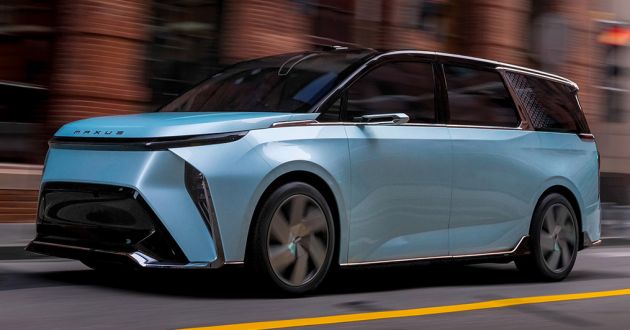Maxus, which is a subsidiary of SAIC Motor, recently unveiled a new electric MPV concept at this year’s Auto Shanghai event. Meant to showcase the company’s new modular platform dubbed Maxus Intelligent Flexible Architecture (MIFA), reports in China indicate the MPV will enter production later in November, with sales set to begin in 2022.
According to the Chinese automaker, the MIFA concept combines a “space capsule” with “oriental charm,” hence the design you see before you. It certainly is very imposing and futuristic, although this is still a show car and the production version will likely undergo some changes.
In any case, it doesn’t stray too far from the people movers of today, with a blocky exterior that serves to maximimse interior space. However, Standout cues on the outside include a wide-width light bar below the Maxus script at the front, with the main headlamps tucked into dugouts on the corners of the bumpers. The big, covered mouth between the three-element lighting clusters sports a geometric pattern and MIFA script on it, while chrome trim helps to frame the jawline.
Down the sides, Maxus introduces some flair by giving the MIFA concept a two-tone paintjob, which is accentuated by a Z-shaped design formed by the window line and C-pillar linked to the roof. Some snazzy aero wheels, hidden door handles, wing cameras, off-coloured skirting and light gold accents add to the visuals, as does the pattern on the rearmost quarter windows.
Moving to the rear, we find a large tailgate spoiler and taillights that extend horizontally and vertically into the bodywork. The latter features a triangular-themed lighting pattern and is bridged by another light bar above the prominent Maxus script. More hints of the off-coloured accent is seen in the lower apron that contains a diffuser-like element.
If you thought the exterior was outlandish, the interior should be out of this world (pun intended) then. Within the cabin, the MIFA concept’s entire dashboard is dominated by a curved screen that extends into the doors. All vital information and controls are accessed through this screen, including feeds for the side cameras.
Touch controls can be seen on the gold lip under the screen and there’s a visual link to the centre console, which contains the gear lever and its wood trim base, as well as another screen for other vehicle functions. Blade-like door handles and a steering wheel that looks like it belongs on race cars are some of the contact points inside, along with patterned upholstery.
It’s even fancier for rear passengers, where there are two individual seats, with the one on the right side having a foot rest in place of a front passenger seat. As with the rest of theme, the seats feature painted metals, wood and what looks like recycled material for the trimmings. An upswept panel between the rear seats houses controls for seat adjustment, climate control and media playback.


As mentioned earlier, this is an electric vehicle, and Maxus is previewing the full capabilities of the platform with the MIFA concept. It gets electric motors on both axles that together, provide 500 kW (680 PS or 671 hp) and 900 Nm of torque, allowing for a zero to 100 km/h time of 3.8 seconds.
These motors draw power from a ternary lithium battery, although the company didn’t provide much in the way of details. Maxus did say that the battery has an energy density of 300 Wh/kg and a range of 600 km is possible. In the future, with solid-state battery technology, those figures are said to go up to 360 Wh/kg and 800 km respectively.
Other features touted by Maxus include a high level of autonomous driving that allows the MIFA concept to park itself once passengers disembark, along with other self-driving functions. The interior also gets an intelligent monitoring system that identifies the preferences of passengers after they are acquainted with the system, and developers can design apps that work with the infotainment system.










The post Maxus MIFA concept revealed as an all-electric MPV – dual motors; 680 PS and 900 Nm; 0-100 km/h in 3.8s appeared first on Paul Tan's Automotive News.



0 Comments